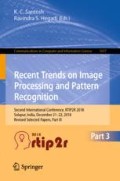Abstract
Social media sites act as a platform for customers to express their opinions/sentiments on brands and products. The opinion of the customers in social media in case of luxury brands plays a great role in improving the sales by building a better brand strategy. Most of the existing analysis used by the luxury brand industry ignores the importance of sarcasm analysis. A common type of sarcasm that is given in the form of opinion is positive sentiments, which contain a negative meaning. This paper studies the scope of Lexicon based approach, K-means and Naïve Bayes for analyzing the sarcastic opinion and analyzing the impact of these algorithms in recognition of sarcasm, which has a negative context for analyzing the luxury, brand data.
Access this chapter
Tax calculation will be finalised at checkout
Purchases are for personal use only
References
Lake, L.: Learn Why Branding Is Important In Marketing (2018). http://www.thebalance.com/why-is-branding-important-when-it-comes-to-your-marketing
Baker, H.: The Difference Between Emotional & Rational Branding (2017). https://bizfluent.com/info-8287442-difference-between-emotional-rational-branding.html
Vaidya, S., Santosh, K.C.: A fast k-nearest neighbor classifier using unsupervised clustering. In: Santosh, K., Hangarge, M., Bevilacqua, V. (eds.) RTIP2R 2016. CCIS, vol. 709, pp. 185–193. Springer, Heidelberg (2016). https://doi.org/10.1007/978-981-10-4859-3_17
Bouguelia, M. -R., Nowaczyk, S., Santosh, K.C., Verikas, A.: Agreeing to disagree: active learning with noisy labels without crowdsourcing. Int. J. Mach. Learn. Cybern. 9, 1307–1319. ISSN 1868–8071, E-ISSN 1868–808X,
Culotta, A., Cutler, J.: Mining brand perceptions from Twitter social networks. Market. Sci. 35, 343–362 (1981)
Liu, X., Burns, A.C., Hou, Y.: An investigation of brand-related user-generated content on Twitter. J. Advertising 46, 236–247 (2017)
Naz, U., Lohdi, S.: Impact of customer self concept and life style on luxury goods purchases: a case of females of Karachi. Arab. J. Bus. Manag. Rev. 6, 192 (2016)
Suhaimin, M.S.M., Hijazi, M.H.A., Alfred, R., Coenen, F.: Identification of common molecular subsequences. Natural language processing based features for sarcasm detection: an investigation using bilingual social media texts. In: 8th International Conference on Information Technology (ICIT). IEEE (2017)
Bharti, S.K., Vachha, B., Pradhan, R.K., Babu, K.S., Jena, S.K.: Sarcastic sentiment detection in tweets streamed in real time: a bigdata approach. Digit. Commun. Netw. http://dx.doi.org/10.1016/j.dcan.2016.06.002
Barbieri, F., Saggion, H., Ronzano, F.: Modelling sarcasm in Twitter, a novel approach. In: Sentiment and Social Media Analysis, pp. 50–58. Association for Computational Linguistics, Baltimore (2014)
Riloff, E., Qadir, A., Surve, P., De Silva, L., Gilbert, N., Huang, R.: Sarcasm as contrast between a positive sentiment and negative situation. In: Conference on Empirical Methods in Natural Language Processing, pp. 704–714. Association for Computational Linguistics, Seattle (2013)
Hu, G., Bhargava, P., Fuhrmann, S., Ellinger, S., Spasojevic, N.: Analyzing users’ sentiment towards popular consumer industries and brands on Twitter. arXiv preprint arXiv:1709.07434 (2017)
Sharma, E.: 10 Branding Elements And What They Mean (2015). http://www.brandanew.co/10-branding-elements-and-what-they-mean/
Rodrigues, P., Costa, P.: Why consumers buy Luxury Brand? Conference proceeding (2016). https://www.researchgate.net/publication/306600838
Phau, I., Lau, K.C.: Brand personality and consumer self-expression: single or dual carriageway. J. Brand Manag. 8, 428–444 (2001)
Yang, C., Pan, S., Mahmud, J., Yang, H., Srinivasan, P.: Using personal traits for brand preference prediction. In: Proceedings of the Conference on Empirical Methods in Natural Language Processing, pp. 86–96 (2015). https://doi.org/10.1016/0022-2836(81)90087-5
Chakraborty, S., Sheppard, L.: An explanatory study on indian young consumers’ luxury consumption: the underlying relationship of interpersonal influence, brand image, brand consciousness and demographic components with luxury brand purchase decision. Int. J. Curr. Eng. Technol. 6, 622–634 (2016)
Jain, S., Khan, M.N., Mishra, S.: Understanding consumer behavior regarding luxury fashion goods in India based on the theory of planned behavior. J. Asia Bus. Stud. 11, 4–21 (2017)
Mostafa, M.M.: More than words: social networks’ text mining for consumer brand sentiments. Expert Syst. Appl. 40, 4241–4251 (2013)
Author information
Authors and Affiliations
Corresponding authors
Editor information
Editors and Affiliations
Rights and permissions
Copyright information
© 2019 Springer Nature Singapore Pte Ltd.
About this paper
Cite this paper
Haripriya, V., Patil, P.G. (2019). Detection of Sarcasm from Consumer Sentiments on Social Media About Luxury Brands. In: Santosh, K., Hegadi, R. (eds) Recent Trends in Image Processing and Pattern Recognition. RTIP2R 2018. Communications in Computer and Information Science, vol 1037. Springer, Singapore. https://doi.org/10.1007/978-981-13-9187-3_58
Download citation
DOI: https://doi.org/10.1007/978-981-13-9187-3_58
Published:
Publisher Name: Springer, Singapore
Print ISBN: 978-981-13-9186-6
Online ISBN: 978-981-13-9187-3
eBook Packages: Computer ScienceComputer Science (R0)

